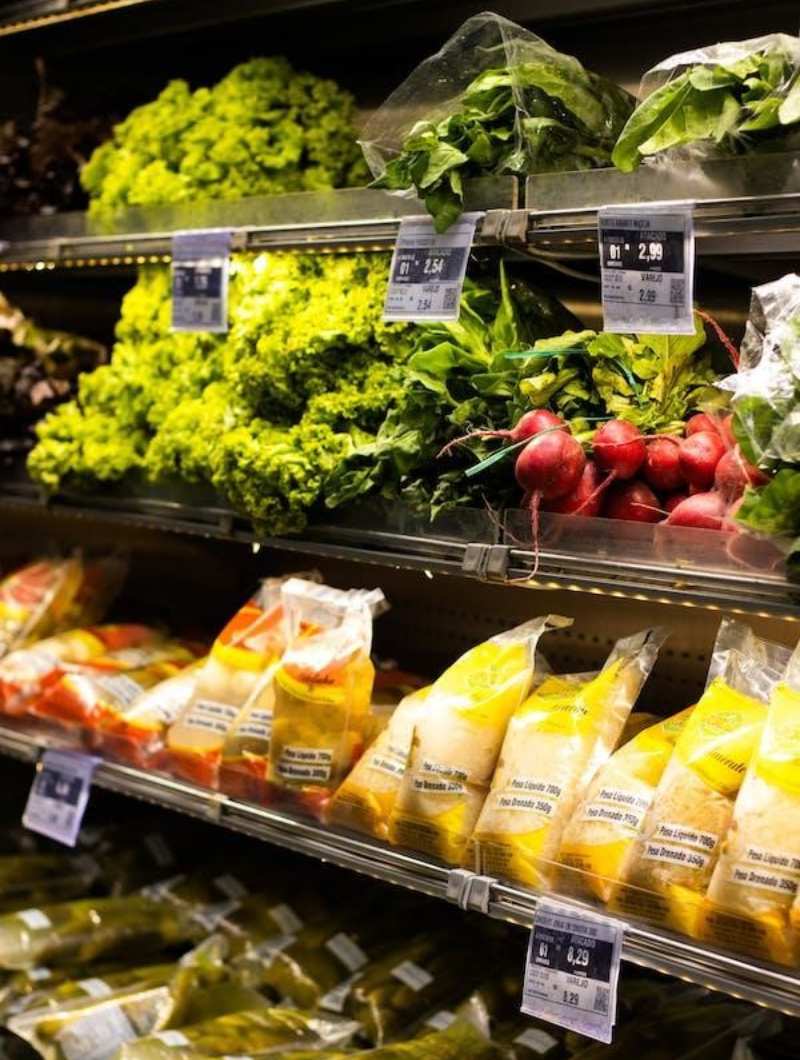The rapidly expanding US-Indian grocery sector offers exceptional potential and difficulties for small and medium-sized firms. The demand for Indian goods is growing due to an expanding Indian population and increased interest in Indian food and culture. You can easily see the US Indian grocery industry’s growth when you go out in the market.

However, several elements must be carefully considered to succeed in this market. These include immigration trends, geographic location, Indian grocery store marketing, e-commerce, technological solutions, supply chain management, etc.
A specialized sector that has been expanding rapidly over the last several years is the Indian grocery market in the US. The market offers distinct obstacles and potential for small and medium-sized enterprises looking to enter this segment.
Various variables, including migration patterns, Indian grocery store locations, marketing, e-commerce, technological solutions, and supply chain management, greatly influence the performance of Indian grocery shops. Indian grocery shop proprietors must thus comprehend these elements and adjust to their clientele’s shifting fashions and tastes.
This article aims to give a general overview of the US-Indian grocery market, the effect of Indian stores & migrants on demand for Indian groceries, the importance of location in the success of Indian grocery stores, effective marketing strategies, e-commerce strategies, technology solutions, supply chain management, and success stories of Indian grocery stores in the US.
Indian grocery shop entrepreneurs may stimulate development and profitability in this particular Indian grocery market size US by mastering these techniques. The Indian grocery industry was estimated to be worth $23.8 billion in 2021; by 2025, it is predicted to be worth$37.8 billion, rising at a compound annual growth rate of 6.4%
The techniques for dominating the US Indian grocery business will be examined in this article, along with information on how Indian grocery shops may adjust to shifting customer tastes and market trends.
Understanding the US Indian Grocery Market
The US Indian grocery business, which serves the requirements of the American Indian population, is a developing niche sector. According to an analysis, the market is anticipated to expand at a CAGR of over 20% between 2020 and 2024.
Spices, cereals, lentils, snacks, candies, and ready-to-eat meals are just a few of the many goods available on the market. Many small and medium-sized businesses fight for clients in this highly fragmented market.
Indian grocery businesses must comprehend the demands and tastes of their consumers if they are to flourish in this Indian grocery store marketing. For instance, although some clients could be interested in purchasing traditional Indian goods, others might search for cutting-edge things that suit their interests. To keep their consumers interested and delighted, Indian grocery shops must remain current with the newest trends and product advancements.
The Impact of Immigration on the Indian Grocery Market
Immigration trends significantly impact the Indian grocery business in the US. The demand for Indian foods rises as more Indians relocate to the US. The second-largest immigration group in the US after Mexicans was approximately 2.7 million Indian immigrants in 2019. There is also a growth seen in Indian grocery appeal to non-Indians.
Indian grocery market size US have adjusted to these developments by increasing the variety of products they sell to meet the varied demands of their patrons. To draw on a broader client base, several retailers, for instance, now carry goods from neighboring South Asian nations like Pakistan and Bangladesh.
Online purchasing and delivery options are another way Indian grocery businesses have changed to reflect shifting Immigration’s influence on Indian groceries trends. Customers may now order goods from anywhere in the US, regardless of where they are. To be competitive in the market, Indian grocery retailers must maintain their agility and react to shifting immigration trends.
The Role of Location in the Success of Indian Grocery Stores

For them to succeed, having a good Indian grocery store location is essential. The performance of stores in Indian-populated regions is often better than those in less-Indian-populated places. However, other elements like parking, visibility, and accessibility all matter. Indian grocery businesses on significant thoroughfares or in shopping malls often draw more customers than those in remote areas.
Indian grocery shop operators must perform market research to determine places with a strong demand for Indian goods to choose the optimal site. They must also consider local competitiveness, parking availability, and other facilities that might improve consumers’ shopping experiences.
Marketing Strategies for Indian Grocery Stores

Indian grocery store marketing success depends on effective marketing. Indian grocery companies may effectively contact their target demographic through print advertisements, Indian grocery social media, and email marketing. However, the marketing message must be tailored to the customer’s demands. For instance, marketing to families may need a different strategy than marketing to young professionals.
Indian grocery shop entrepreneurs must recognize their target market and comprehend their requirements and preferences to succeed. Additionally, they must create a solid brand identity and use unified messaging and Indian store promotion tactics across all marketing platforms. Further, loyalty programs and other rewards may help Indian grocery companies draw in and keep consumers by fostering connections with them.
E-commerce Strategies for Indian Grocery Stores
The COVID-19 epidemic has expedited the trend to online purchasing, and the Online Indian store impact is no exception. E-commerce sites provide Indian grocery retailers with a chance to contact more customers and boost sales.
E-commerce also needs help, such as maintaining inventories and making sure deliveries are made on schedule. To compete in e-commerce, Indian food retailers must make the necessary technological and logistical investments.
Indian grocery businesses must have a user-friendly website and provide a broad selection of items with in-depth descriptions and photographs to succeed in e-E-commerce’s influence on Indian groceries. Additionally, they must ensure that the ordering and payment procedures are easy and safe.
Offering incentives to clients, such as free shipping or discounts, may also aid in drawing them to your online company. To guarantee prompt and correct order delivery, Indian grocery retailers must also set up effective supply chain management and logistics systems.
Technology Solutions for Indian Grocery Stores
Indian grocery companies may boost customer satisfaction and optimize operations using Tech’s role in Indian store operations. Technology such as point-of-sale systems, inventory management software, and digital signage may help grocery shops run more efficiently in India.
Point-of-sale systems, for instance, may assist retailers in managing inventory, monitoring sales, and producing data. Retailers can monitor stock inventories, improve pricing, and cut waste using inventory management software. Stores may use digital signage as an Indian store promotion tactic to advertise new goods and limited-time deals to consumers.
Indian grocery businesses must determine their unique requirements and make the appropriate tool investments to integrate digital solutions effectively. Additionally, they must ensure that personnel is adequately taught to utilize Indian grocery store tech and that clients are informed on online ordering and other digital platforms.
Supply Chain Management for Indian Grocery Stores
Successful Indian store placement depends heavily on supply chain management. It is crucial to guarantee product variety, quality, and availability to satisfy client requirements. Food must be delivered on schedule and in excellent shape. Therefore Indian grocery companies must build partnerships with dependable suppliers. Additionally, they must carefully control inventory levels to prevent stockouts and reduce waste.
Indian grocery businesses need to develop open lines of communication with their suppliers and consumers to succeed at supply chain management. To keep their product offers current and alluring to consumers, they must monitor market trends and adjust to shifting consumer tastes.
Success Stories from US Indian Grocery Stores

Several prosperous Indian grocery shops in the US have put strong US Indian grocery industry growth and profitability-driven strategies into practice. For instance, some retailers have increased the variety of goods they sell by adding non-food products like apparel and housewares. Other people have invested in technological solutions like online ordering and delivery to reach a larger audience.
Customers are given priority in successful Indian grocery shops, and they develop enduring connections with them. To entice consumers to return, they give samples, provide tailored suggestions, run loyalty campaigns, and offer other Social media marketing for Indian stores.
Conclusion
There are prospects for small and medium-sized firms in the US Indian grocery industry growth. Indian grocery stores must comprehend the needs and preferences of their customers, adapt to shifting immigration patterns, choose the ideal location, implement efficient marketing and e-commerce strategies, use technology solutions, and effectively manage their supply chain if they are to succeed in this market. US Indian grocery industry growth may foster development and boost profitability while meeting consumer requirements by implementing these methods.

Shrey Chaudhary
Experienced freelancer in multiple domains such as content writing, digital marketing, and virtual assistant. Shrey's a learner and an explorer who keeps taking risks and always learns from them. If you are looking for a genuine, and experienced freelancer in the any of mentioned domains below, Get excited! You are reading the right profile. 1. Content Writing. 2. Social Media Marketing. 3. Shopify Virtual Assistant 4. E-Commerce Product Listings. Contact Shrey Now!


